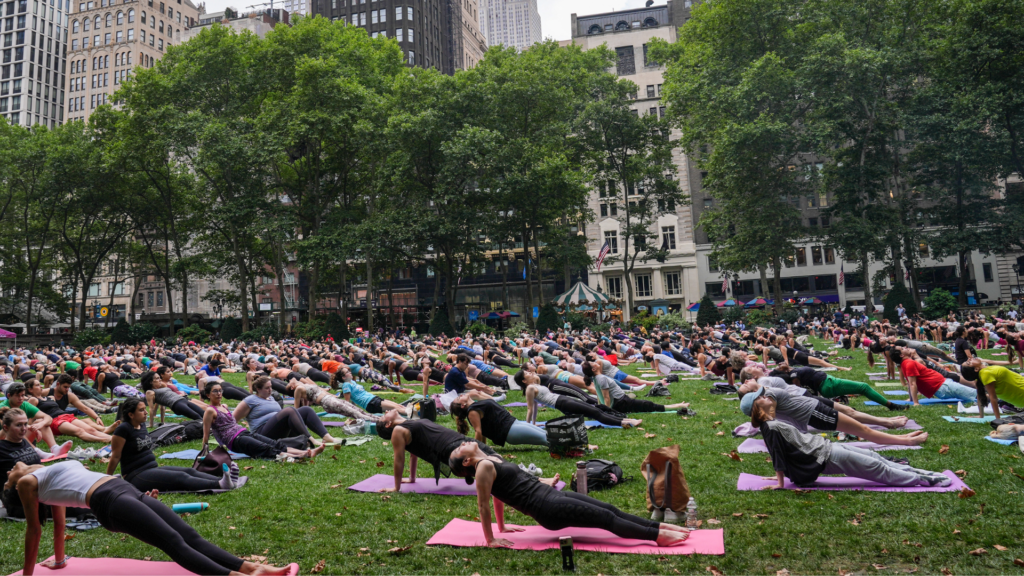“], “filter”: { “nextExceptions”: “img, blockquote, div”, “nextContainsExceptions”: “img, blockquote, a.btn, a.o-button”} }”>
Heading out the door? Read this article on the new Outside+ app available now on iOS devices for members!
>”,”name”:”in-content-cta”,”type”:”link”}}”>Download the app.
Last year, two yoga teachers challenged the city of San Diego in court after it tried to ban outdoor yoga at public parks and beaches. Eventually, after a year-long court case, the teachers of these group classes prevailed. Yet it’s a reminder to teachers everywhere that using the outdoors as a backdrop to your yoga classes isn’t as simple as it might seem.
Organizing any event in a public space requires an understanding of the local regulations and permit processes. (Fun!) But because these requirements vary drastically by location, the process of learning what is legally needed can demand some careful research—and some serious breathwork.
So, Do You Need a Permit to Teach Outdoor Yoga?
A park is a park is a park, right? Not from the perspective of the government.
“Each type of land—state parks, city parks, forest service—has its own system and rules,” explains Emily Dresser, who teaches yoga outdoors in Bend, Oregon.
Whether or not a permit or license is required depends largely on the location, although it might also depend on the number of attendees and whether the class is free or for profit. For example, parks in Milwaukee, Wisconsin, require a special event permit that starts at $150 and, depending on the number of attendees, maxes out at $700. For-profit classes in Portland, Oregon, require a commercial activity permit and an application fee of $150. Want to hold class in a park in Cleveland, Ohio? You’ll need to put in your application more than 45 days in advance and pay a $30 non-refundable fee for each date of your event.
Although not every municipality requires a permit for you to teach. Emily Phillips, who previously taught yoga in Los Angeles’s 4000-acre Griffith Park, didn’t seek approval once throughout the five years she led outdoor classes. “I looked into getting a permit, but I learned that if your classes are donation-based, you don’t need a permit,” she said.
Phoenix-based teacher John Kaye also led yoga classes in a downtown park for years without a permit. Applying for one literally didn’t occur to him. “I never checked with anyone,” he says. “Nobody has ever said one word.”
According to the City of Phoenix’s Parks and Recreation Department website, Kaye wouldn’t have required special permission because his classes didn’t exceed 50 attendees. Kaye didn’t charge attendees, and when some students wanted to donate, he accepted their cash offerings and gifted them to a local food bank. According to the local Maricopa County website, he might have needed a special use permit if he had charged students a flat fee. That’s because his classes would have been considered a commercial venture. It’s unclear which permit stipulation takes precedent if more than one situation applies.
So how are you supposed to know which, if any, paperwork you need?
How to (Legitimately) Teach Outdoor Yoga
Securing the necessary permits is not always as straightforward as one might imagine. Following are the essential things you’ll need to know as you research local regulations.
1. Research Where You Want to Teach
Don’t show up half an hour before you intend to teach and hope for the best. Weeks prior to the event, search online for the name of the specific park or location along with “events” or “permits.”
In most cases, you’ll land on the Parks and Recreation Department for your town, city, municipality, county, or state. From there, you’ll be able to explore the specific regulations related to events.
2. Anticipate Attendance
The size of your class might determine whether a permit is needed. But the specifics related to the permit are also relevant. Because permits sometimes restrict the number of people who can participate in events, Dresser had to learn how to be okay turning people away.
“Sometimes people show up without registering, which is hard because my permits have strict limits on group size,” she says. “I want my classes to feel welcoming and inclusive for everyone, so turning someone away once they arrive at the park is one of the hardest things I’ve had to do.”
3. Consider What You’ll Charge
Will your classes be free? Donation-based? The same cost as your indoor or online classes? This information might determine not only the kind of permit you need but its cost. Also, some cities require teachers who charge for class to obtain a commercial license. Read the fine print.
4. Know the Necessary Certifications and Insurance Requirements
Depending on where you live, you may also need to present proof of liability insurance, which is always a smart idea as a yoga teacher. You may also need other certifications prior to obtaining a permit.
“I had to get certified as an Oregon Outfitter Guide, carry commercial insurance, complete my Wilderness First Responder training, and agree to uphold all the land-use regulations,” explained Dresser. Each of these certifications requires annual renewals and fees.
5. Plan in Advance
Many Parks and Recreation departments require you to submit your permit application a minimum of 30 days prior to your intended class date. Some require considerably more notice. Select a date and don’t procrastinate on the paperwork.
6. Ask Questions
If, after reading the fine print, you’re left uncertain regarding the regulations, reach out to the department or agency overseeing the location where you intend to teach for clarification.
“Navigating permits wasn’t easy,” says Dresser. It took phone calls and persistence before she finally began teaching in Drake Park and Tumalo State Park. It may take some time although ultimately, it’s less expensive and frustrating than needing to pay a fine or, worse, having your class shut down.


